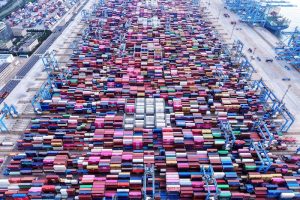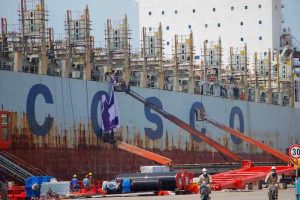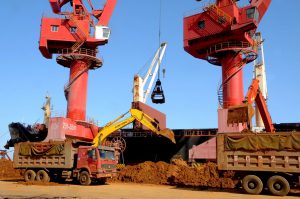Deflationary pressures on the world’s second largest economy eased in August, even as demand remained weak, data released by China’s statistics bureau showed on Saturday.
China’s consumer prices returned to positive territory while factory-gate price declines slowed, pointing to signs of stabilisation in the economy.
“There is a bit of improvement in the inflation profile. In the meantime, the PPI deflation appears to be narrowing, pointing to a slow and moderate restoring process,” said Zhou Hao, chief economist at Guotai Junan International.
Also on AF: Yuan Dives to Lowest Level in 16 Years as Recovery Wanes
“In general the inflation (rate) still points to weak demand and requires more policy support for the foreseeable future.”
China’s consumer price index (CPI) rose 0.1% in August from a year earlier, compared to a 0.3% fall in July. Core inflation, which excludes food and fuel prices, was unchanged at 0.8% in August.
The producer price index (PPI), meanwhile, fell 3.0% from a year earlier, as against a 4.4% drop in July. The drop in factory prices was the smallest in five months.
Analysts say China will need to introduce more policy support to shore up consumer demand, with a labour market recovery slowing and household income expectations uncertain.
Climate woes adding to pressure
Food prices fell 1.7% on year while non-food costs rose 0.5% – led by rising costs linked to tourism, China’s National Bureau of Statistics said.
Recent floods have damaged corn and rice crops in China’s key northern grain-producing belt, sparking domestic food inflation fears as consumers worldwide face tightening food supplies caused by the war in Ukraine.
“Both CPI and PPI are likely to show modest improvements in the fourth quarter,” said Luo Yunfeng, an economist at Huajin Securities.
Pork prices rose 11.4% month-on-month, versus no change in July, due to the impact of extreme weather in some areas. They were down 17.9% from a year earlier, narrowing from a 26% drop on July.
China’s anaemic price changes contrast sharply with the surging inflation most other major economies have seen since the Covid-19 pandemic waned, forcing their central banks to rapidly raise interest rates.
China in July became the first of the Group of 20 wealthy nations to report a year-on-year decline in consumer prices since Japan’s last negative headline CPI reading in August 2021.
View this post on Instagram
Industrial demand picking up
Factory-gate deflation moderated in August due to improving demand for some industrial products and rising international crude oil prices, the statistics bureau said.
August trade data showed China’s exports and imports both narrowing their declines, joining a run of other indicators showing a possible stabilisation in the economic downturn, as policymakers seek to spur demand and fend off deflation.
“With early signs of growth stabilisation, we see deflationary pressures easing, a trend reflected in higher commodity prices in August,” ANZ analysts said in a note.
Beijing has announced a series of measures in recent months to shore up growth, including mortgage rate cuts and the easing of borrowing rules last week by the authorities to aid home-buyers.
China’s central bank could continue to cut interest rates and bank reserve requirement ratios, said Bruce Pang, chief economist at Jones Lang Lasalle.
Premier Li Qiang said this week that China is expected to achieve its 2023 growth target of around 5%, but some analysts believe the target could be missed due to a worsening property slump, weak consumer spending and tumbling credit growth.
- Reuters, with additional editing by Vishakha Saxena
Also read:
China Facing Reality Check After Long Boom Built on Debt
China Moves to Boost Affordable Housing, Home Loans Amid Crisis
China’s Big Banks Cut Rates, Prepare to Lower Mortgages
Typhoons, Floods, Heatwaves Cost China Economy $5.7bn in July
Critical China Factory Hubs Face Greatest Climate Change Risk






















